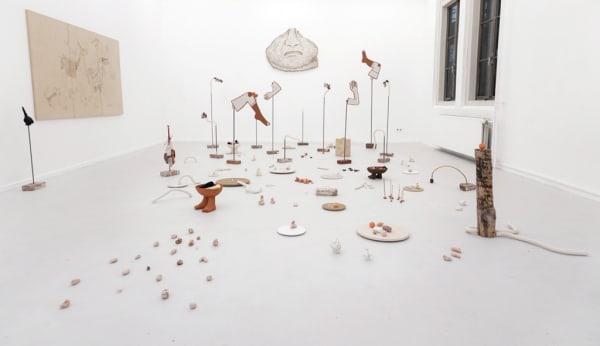Claudia Martínez Garay: I WILL OUTLIVE YOU
GRIMM is pleased to announce I WILL OUTLIVE YOU by Claudia Martínez Garay (b. 1983 PE) at our New York gallery space. This marks the artist’s first solo exhibition with the gallery, and the artist’s first solo exhibition in the United States. Claudia Martínez Garay’s work is in dialogue with the impact of colonialism on cultural artifacts, questioning how cultural artifacts are created, preserved, transformed and circulated. Presented is a single-channel HD video ÑUQA KAUSAKUSAQ QHEPAYKITAPAS / I WILL OUTLIVE YOU (2017), and an installation of ceramics and paintings ... imaywanpas quidakuwakmi ... / ... but you can stay with my stuff ... (2017).
Claudia Martínez Garay’s work investigates objects’ journeys between their origin and destination, suggesting that the information accrued in these transitory spaces holds value and power. After encountering a ceramic vase at the Ethnological Museum of Berlin depicting a Moche prisoner moments before he was sacrificed, Claudia Martínez Garay began speculating how art can underline implications of cultural appropriation and contribute to creating narratives that challenge, and complicate, the discourse of domination and cultural hegemony. Death and sacrificial rituals were an important part of Moche society and cultures, and the archetype of prisoner - through its diverse transmutations - is explored in ÑUQA KAUSAKUSAQ QHEPAYKITAPAS / I WILL OUTLIVE YOU (2017). The video is a form of personal and shared storytelling, with fact and fiction intersecting and blurring together. The timeline in the video shifts from the prisoner’s state of mind prior to his death to his childhood, to its transfiguration into a digital being, to its knowing incarceration as an artwork on display.
Using artifacts and their attributed narratives to investigate their origins and transformations, ... imaywanpas quidakuwakmi ... / ... but you can stay with my stuff ... (2017) presents ceramic objects as an installation in dialogue with these inquiries. The nuanced works behave as props, performing alongside one another, serving as an offering for an incomplete and broken face hanging on the wall that mirrors the prisoner in the film. Ceramic animals appear on the ground and atop other objects, painted corn sits in bowls with legs and feet, limb like forms attached to metal rods spring out of bricks. Interested in studying the object’s own surface and materiality, she sees the surface of ceramics as a product of the desert landscape - the original space where the objects symbolism is derived from. Each object has its own biography, its own history. While individual works are fragile and symbolic, together they form a collective that is powerful and analytical.






